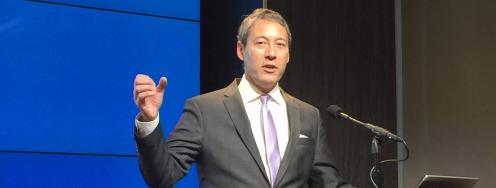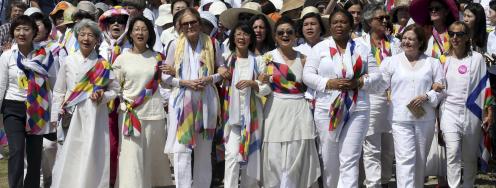More Misconduct at Missile Silos
On the radar: Nuclear missile corps under investigation; Harsh criticism of the planned air-launched cruise missile; Bomber contract is politics as usual; Nuclear signalling ineffective; High stakes for the Nuclear Security Summit; Monitoring enriched uranium; and Dealing with North Korea realistically.
Drug abuse at nuclear weapons sites - “Fourteen members of an Air Force unit responsible for guarding nuclear missiles in Wyoming, Colorado and Nebraska are under investigation for possible illegal drug activity, including cases involving cocaine use, defense officials said Friday. The probe is a fresh blow to a nuclear missile corps that has been under intense scrutiny in recent years for a string of lapses in training and personal conduct, first revealed by The Associated Press,” writes Robert Burns for AP.
--“The command is responsible for the entire fleet of 450 Minuteman 3 nuclear missiles that stand in underground launch silos, one third of them operated by the 90th Missile Wing. The missile force is on alert 24 hours a day, year-round, requiring strict adherence to performance standards by the men and women who operate, maintain and protect them.” Full story here. http://wapo.st/259DpCB
See also - “Antiquated Helicopters Protect America’s Nuclear Missile Sites,” by Darien Cavanaugh for War is Boring. http://bit.ly/1VzNSmG
ALCM dangerous and wasteful- “The Obama administration’s fantastical plan to modernize the Cold War-era nuclear triad of land-based missiles, submarine-launched missiles, and long-range bombers is prompting an increasingly loud and much-needed debate in Washington and beyond about whether the effort is necessary and sustainable. One of the most controversial pieces... is the Air Force’s proposal to build a new fleet of roughly 1,000 nuclear-capable air-launched cruise missiles (ALCMs),” writes Kingston Reif for War on the Rocks.
--“Devotees of the missile often emphasize other supposed attributes of the system, including that it would come in handy in potential scenarios involving limited nuclear escalation… The notion the use of nuclear weapons can be fine-tuned to carefully control escalation to a full-scale nuclear exchange is very dangerous thinking. It is highly unlikely that an adversary on the receiving end of a U.S. nuclear strike would (or could) distinguish between a large warhead and a small warhead. The fog of war is thick. The fog of nuclear war would be even thicker.” Read the article here. http://bit.ly/1PmjGEb
Tweet - @StephenUCS: .@SenFeinstein explains why the proposed new nuclear-armed cruise missile is bad for US security
New bomber debate gets political - “Air Force Secretary Deborah James and Chief of Staff General Mark Welsh listed seven companies who will build components for the new [B-21 bomber] plane at a state of the Air Force press conference. They didn’t provide many details as to what those contributions will be, but a quick look at the history of the companies provides some indication of how this project will be built. It also shows the program is being designed to have broad political support by spreading the work across numerous states and congressional districts,” writes Dan Grazier for the Project on Government Oversight.
--“Veteran military reformer Franklin ‘Chuck’ Spinney describes political engineering as ‘business as usual’ for programs of this kind. ‘By designing overly complex weapons, then spreading subcontracts, jobs, and profits all over the country, the political engineers in the Defense Department deliberately magnify the power of these forces to punish Congress, should it subsequently try to reduce defense spending by terminating major procurement programs.’” Full article here. http://bit.ly/1pwyhsf
Tweet - @nukes_of_hazard: A separate account for #nuke modernization does not solve underlying funding issues. Taxpayers still on the hook. http://bit.ly/1U1IMjK
Nuclear signalling a fool’s errand - “In a recent article in Breaking Defense, Adam Lowther and Chris Winklepleck argue that the strategic aircraft leg of the triad provides unique ‘nuclear signaling’ capabilities essential to demonstrating the seriousness of U.S. nuclear threats… They are wrong. This aerial flexing of nuclear muscle has done nothing to ease tension on the Korean peninsula or improve North Korea’s behavior,” writes Jim Doyle for Breaking Defense.
--“Nuclear signaling is a dangerous game with an unimpressive track record. It is perhaps more effective in its second objective, which is to reassure allies of the U.S. commitment to their defense, but even this desired outcome cannot be tested for success. Besides, the Trident missiles aboard U.S. nuclear submarines are constantly providing extended deterrence for all nations under the U.S. nuclear umbrella. This capability remains invulnerable and can deliver nuclear weapons to any point on the globe.” Full article here. http://bit.ly/1LDNyBf
A crossroads in nuclear security- A Belfer Center report details the steps countries need to take at the 2016 Nuclear Security Summit. “On a high-security path, all nuclear weapons and weapons-usable nuclear material worldwide would be effectively and sustainably protected against the full range of plausible threats that terrorists and thieves might pose; the number of locations where such stocks exist would be drastically reduced; steps would be taken to build understanding of the threat, to strengthen security culture, and combat complacency; and nations would continue an effective dialogue.”
--“On a low-security path, many stocks would remain dangerously vulnerable; few further actions would be taken to minimize the number of locations where nuclear weapons and their essential ingredients exist; complacency about the threat and weak security cultures would increasingly be the norm; and what little international discussion of nuclear security continued after the summit would be mired in political disputes and bureaucratic obstacles... Nuclear security progress would stall and eventually reverse — and the risks of nuclear terrorism would grow.” Full report here. http://bit.ly/1VzIdwY
Banning highly enriched uranium - “The global stockpile of [highly enriched uranium] at the end of 2014 was about 1370 tons, sufficient for more than 20,000 simple first-generation Hiroshima type weapons, or more than four times as many modern nuclear weapons… Since [9/11] there also has been increased concern about the relative ease with which terrorists could make an ‘improvised nuclear device’ if they gained access to several tens of kilograms of HEU,” Frank von Hippel writes in a report for the International Panel on Fissile Materials.
--“Although there are challenges in a few cases, it appears that there are paths forward to phasing out virtually all non-weapon use of HEU during the next few decades. During the transition, the large Russian and United States stockpiles of excess HEU could be used to meet the worldwide requirements for HEU for non-weapon purposes. It is feasible therefore to consider going beyond the proposed Fissile Material (Cutoff) Treaty ban on HEU production for weapons to establish a ban on the production of HEU for any purpose.” Full report here. http://bit.ly/1Pp4SEW
See also - “Banning the production of highly enriched uranium,” by Zia Mian, Michael Schoeppner and Frank von Hippel for the Bulletin of the Atomic Scientists. http://bit.ly/1Ui1m7y
A pragmatic vision of North Korea’s future - “Diplomats are fixated on the ‘complete, verifiable and irreversible denuclearization’ [CVID] of North Korea’s nuclear program… For years, the United States has insisted that to return to negotiations, Pyongyang must first take steps towards CVID. This requirement is problematic for two reasons: First, it is counterproductive to set the goal of negotiations as a precondition to talks. Second, it’s likely that the North Korean nuclear program is inherently not reversible,” writes Elizabeth Philipp in National Interest.
--“In the near term, the best that the international community may be able to accomplish is to prevent North Korea from gaining additional technical knowledge or acquiring materials for its weapons program by enforcing Security Council sanctions. The long-term goal should be to welcome North Korea back to the nonproliferation regime and address its security concerns, thereby eliminating its impulse to possess nuclear weapons in the first place.” Full analysis here. http://bit.ly/1Zov7Tg
Tweet - @jstreetdotorg: Talk of “tearing up” #IranDeal is nonsense -- does @realDonaldTrump want Iran to get its centrifuges back and restart its reactor too? #pc16
Quick Hits:
--“Why Analysts Aren't Laughing At These Silly North Korean Photos,” by Geoff Brumfiel for NPR. http://n.pr/1UhN2fl
--“Plutonium Pie in the Sky: the Dangerous Delusion of New Nukes,” by James Heddle for CounterPunch. http://bit.ly/22tMSWL
--“DoD Beginning to Tackle Nuclear ‘Bow Wave’,” by Jon Harper for National Defense Magazine. http://bit.ly/1VzCPdk
--“Clinton Should Double Down on Iran Diplomacy, Not Containment,” by the National Iranian American Council. http://bit.ly/25iXWVo
--“The Trillion Dollar Question the Media Have Neglected to Ask Presidential Candidates” by Lawrence Wittner for Moyers & Company. http://bit.ly/1ZnmQyS
Events:
--“Inside North Korea Today: Working for Peace on the Korean Peninsula,” featuring Linda Lewis, American Friends Service Committee. March 23 from 2:30 to 4:00 p.m. at George Washington University, 1957 E St. NW, Conference Room 505, Washington. RSVP online. http://bit.ly/1LojlGm
--Mark Fitzpatrick, International Institute for Strategic Studies, book discussion on Asia's Latent Nuclear Powers: Japan, South Korea and Taiwan. March 24 from 12:00 p.m. to 1:15 p.m. at the University of Maryland, 1203 Van Munching Hall, College Park, MD. Open to the public. http://bit.ly/1Pp6lea
-- “From Pyongyang to Tehran: U.S. and Japanese Perspectives on Nuclear Deals,” with seven speakers. March 28 from 2:00 to 5:30 p.m. at the Carnegie Endowment, 1779 Massachusetts Ave. NW, Washington. RSVP online. http://ceip.org/1o1wo4V
--“Predicting the Health Consequences of Nuclear Terrorism Scenarios,” with Timothy Jorgensen, author of Strange Glow: The Story of Radiation. March 28 from 4:00 to 5:30 p.m. at the Center for Strategic and International Studies, 1616 Rhode Island Ave. NW, Washington. RSVP here. http://bit.ly/1UJ8UOX
--“Beyond the Nuclear Security Summits: The Role of Centers of Nuclear Security Excellence,” featuring Jongsook Kim, Korea Institute of Nuclear Nonproliferation; Yosuke Naoi, Japan Atomic Energy Agency; and Zhenhua Xu, China State Nuclear Security Technology Center. March 29 from 9:45 a.m. to 12:00 p.m. at the Center for Strategic and International Studies, 1616 Rhode Island Ave. NW, Washington. RSVP by email. Webcast on the CSIS website. http://bit.ly/1U211pj
Dessert:
‘Renegade’ is keeping the nukes - “President Obama is planning to take the nation’s nuclear launch codes with him when he leaves office, in January of 2017, the President announced in a nationally televised address on Thursday. The President was quick to acknowledge that his decision to hold on to the launch codes was unorthodox, but said that he was doing it ‘to reassure the American people,’” writes Andy Borowitz in his satirical column in the New Yorker.
--“‘In recent weeks, there has been a rising level of alarm about who might have access to these codes going forward,’ Obama said. ‘As a result, it occurred to me that the safest thing would be if I just held on to them for the foreseeable future.’ … At the conclusion of his address, Obama held up the nuclear ‘football,’ the briefcase containing the nation’s nuclear codes, to display it for the national television audience. ‘You can all sleep well at night,’ he said. ‘I got this.’” Full article here. http://bit.ly/1S3psfK



